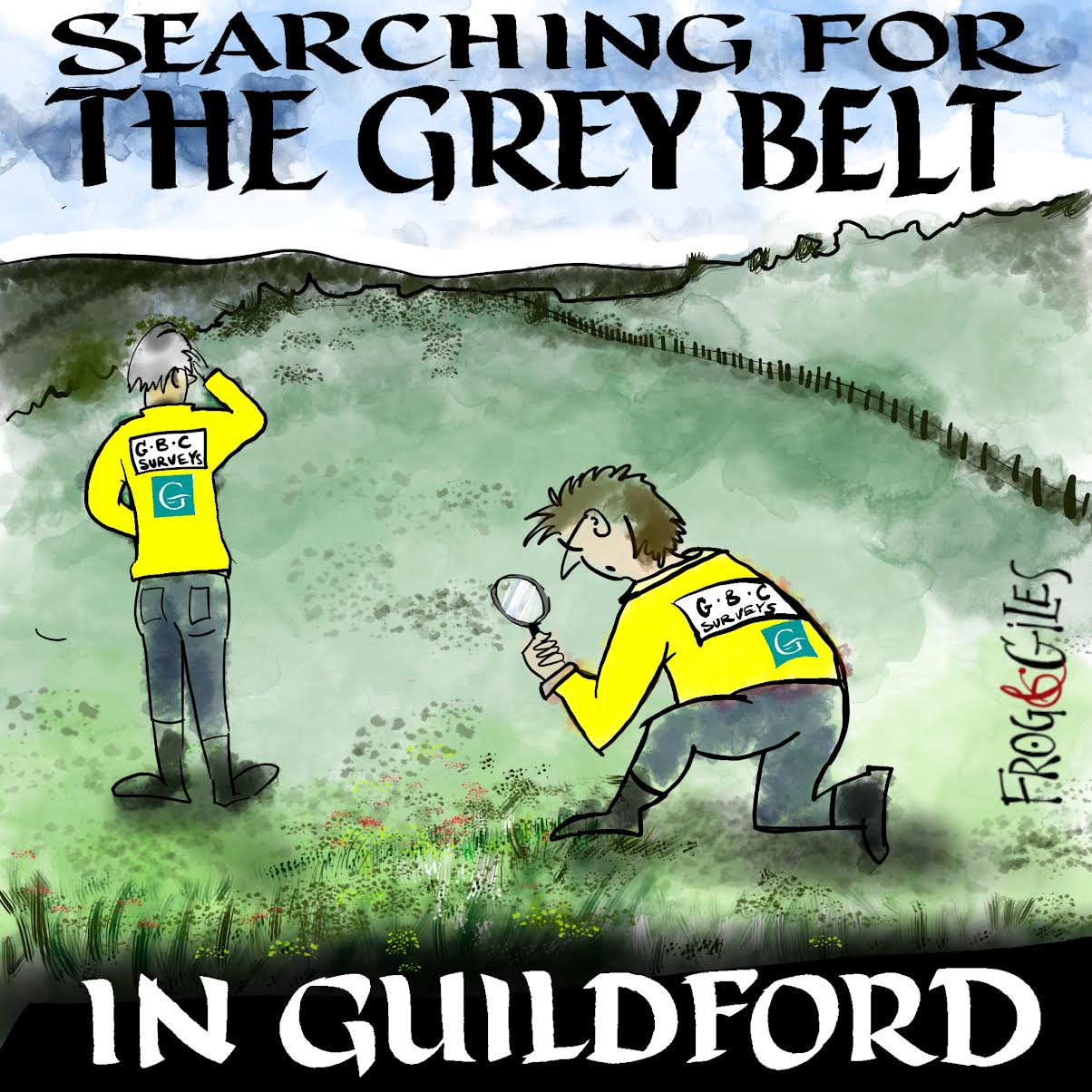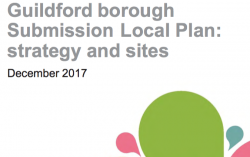 Abraham Lincoln
If given the truth, the people can be depended upon to meet any national crisis...
Abraham Lincoln
If given the truth, the people can be depended upon to meet any national crisis...
 Guildford news...
for Guildford people, brought to you by Guildford reporters - Guildford's own news service
Guildford news...
for Guildford people, brought to you by Guildford reporters - Guildford's own news service
Letter: Green Belt Protection And Town Regeneration Are Both Necessary
Published on: 10 Jan, 2018
Updated on: 10 Jan, 2018
I write to answer to Peter Knight’s question: “Why should we put up with that little type of development in isolation whilst those in [Lovelace Ward (Ripley, Wisley and Ockham)] have none? in his comment on Cllr Cross’s letter: The Council Paid No Heed to the Public Over the Local Plan.
Without new development in town of a sensible height and density (not skyscrapers, but higher and denser than now), the centre of Guildford will continue to rot and countryside will be ruined forever, since greenfield sites are cheaper to build on.
Towns are where people (especially the young) want to live and work, and where there is existing infrastructure. We’ve nothing to fear from well-planned urban buildings. We’ve a lot to fear from plastering the borough with a gulag of monster housing estates (alias “garden villages” etc) as Guildford Borough Council proposes.
How many times does it need spelling out that protecting the green belt and regenerating our towns are not alternative options but mutually supportive policies? Are we so blind that we can’t see how shabby Guildford has become, and that more retail instead of housing will only make this worse?
Are we too stupid to calculate the value of the economic, environmental, social, recreational and health services that our countryside provides to everyone, town and country dwellers alike?
Developing some brownfield sites in the green belt is quite acceptable. The council’s belated and woefully incomplete brownfield register identifies one or two near where I live. But putting 70% of new housing on green fields and 58% in the green belt, while removing two-thirds of the borough’s villages from it, is insanely disproportionate – as I trust the planning inspector will recognise as he examines the council’s submitted Local Plan.
There is another approach, called fair burden-sharing. Settlements should accommodate new development in proportion to their current population, on the basis of openly calculated housing need (not secret formulas and developers’ wishes as now).
Thus, for instance, Guildford town would accept 20 times more new housing than East Horsley. Parish councils could be challenged to suggest where their quota should go, in consultation with residents, with suitable budgetary and other incentives.
This wouldn’t solve everything: if anything, there would be more public argument, not less. But at least it would be an inclusive, democratic, bottom-up approach, engaging people at the grass-roots rather than talking down to them like Cllr Spooner’s very defensive response to criticism of his beloved Local Plan in Parliament.
In this, he asserts, without evidence, that “exceptional circumstances” have already been met for building on green fields. His sheds crocodile tears about sacrificing X per cent of green belt to development, like Jonathan Swift in his ‘Modest Proposal’ but less funny.
The percentage scarcely matters: the green belt is a solemn, public, national, inter-generational covenant to protect in perpetuity, enshrined in primary legislation. It is not a plaything for local bumbledom and developers.
Responses to Letter: Green Belt Protection And Town Regeneration Are Both Necessary
Leave a Comment Cancel replyPlease see our comments policy. All comments are moderated and may take time to appear. Full names, or at least initial and surname, must be given.

"Found any?" - "Nope, it all looks green to me!" (See Opinion: The Future is Congested, the Future is Grey)




Recent Articles
- Changes to Borough Council’s Christmas Waste Collection Service
- Mayor Remembers the Cost of War with Guildford’s Twin – Freiburg
- Big Leaf Foundation Wins King’s Award for Voluntary Service
- Notice: Licence Application for Retailing Alcohol at Walnut Unimart
- Letter: I Invite Guildford’s MP to See the ‘Orgy of Housebuilding’ Before Infrastructure Improvements
- Threats to Staff and Fly-tipping Result in Closure of Recycling Centre
- Ash Level Crossing Will Not Close in December, SCC Assures Residents
- Sara Sharif Trial Latest – The Judge Reviews the List of 71 Injuries Found on Sara
- Column: Guildford’s MP Writes – Championing the Needs of Guildford and Our Villages
- City Win at Last With Three Penalties in Cup Tie


Recent Comments
- Jim Allen on Ash Level Crossing Will Not Close in December, SCC Assures Residents
- Olly Azad on City Win at Last With Three Penalties in Cup Tie
- Warren Gill on Ash Level Crossing Row: GBC Rejects Cabinet Member’s Statement As ‘Factually Incorrect’
- Olly Azad on Heartbreak for City Again as Two Extra-time Goals Snatch Victory
- Brian Holt on Heartbreak for City Again as Two Extra-time Goals Snatch Victory
- Helen Skinner on County Council Cabinet Confirms Its Decision on London Road Scheme
Search in Site
Media Gallery
Dragon Interview: Local Artist Leaves Her Mark At One of England’s Most Historic Buildings
January 21, 2023 / No Comment / Read MoreDragon Interview: Lib Dem Planning Chair: ‘Current Policy Doesn’t Work for Local People’
January 19, 2023 / No Comment / Read MoreA3 Tunnel in Guildford ‘Necessary’ for New Homes, Says Guildford’s MP
January 10, 2023 / No Comment / Read More‘Madness’ for London Road Scheme to Go Ahead Against ‘Huge Opposition’, Says SCC Leader
January 6, 2023 / No Comment / Read MoreCouncillor’s Son Starts Campaign for More Consultation on North Street Plan
December 30, 2022 / No Comment / Read MoreCounty Council Climbs Down Over London Road Works – Further ‘Engagement’ Period Announced
December 14, 2022 / No Comment / Read MoreDragon Interview: GBC Reaction to the Government’s Expected Decision to Relax Housing Targets
December 7, 2022 / No Comment / Read MoreHow Can Our Town Centre Businesses Recover? Watch the Shop Front Debate
May 18, 2020 / No Comment / Read More







Jim Allen
January 10, 2018 at 2:27 pm
While I whole heartedly support the promise of fair burden share throughout the borough, there has to come a time when an area can say enough is enough and this area is ‘at capacity’.
In Burpham, the community has doubled in size since the intersection of the A3 bypass in 1980.
Its infrastructure is running at capacity and for the past 10 years has had more garden grabbing than any other ward.
Yes, balanced distribution, but with the caveat when capacity is reached put them somewhere else!
Jules Cranwell
January 10, 2018 at 4:22 pm
This is an excellent analysis. If only we had such perceptive on the council’s Executive, they would see this issue with equal clarity.
David Smith
January 10, 2018 at 7:57 pm
Developments of sensible height and density will only deliver apartments in Guildford’s limited brownfield sites.
The Surrey Advertiser last week listed 53 brownfield sites promoted by Guildford Borough Council. In Guildford town centre these included just seven sites that could be used for actual houses and not flats.
Some of these sites are questionable. For example, Windy Ridge on Pewley Hill, identified as a site but with planning for two six-bedroom detached houses. Is this really satisfying Guildford’s housing need?
So let’s not be fooled that Guildford’s housing need can be solved with the limited number of sites we have in the town.
We need houses, families with children need houses and in the majority of cases these can only be delivered on the green belt.
I have to say that I agree with Pete Knight, Guildford town centre can accommodate more, but we are not a dumping ground and I am very pleased to see that those making the decisions have realised this.
The Local Plan has been submitted for consideration, let’s see what the planning inspectorate says.
Colin Cross
January 11, 2018 at 1:46 pm
Let’s take a look at the information in the submitted Guildford Borough Council Local Plan, for the 15 years between 2019 and 2033. The plan is to build approx 12,600 homes across the borough.
The breakdown of where these are going is as follows:
Green belt Locations: Blackwell Farm 1,800, Wisley/Ockham 2,000, Gosden Hill 2,000, miscellaneous villages 2,186. Sub-total 65%.
Slyfield project and Jacobs Well 1,000, Ash and Tongham areas 1,320, Guildford town centre and small urban sites 2,100, miscellaneous sites including traveller accommodation 200. Sub-total 35%.
Note: only a maximum of 17% of homes built will be in Guildford town centre probably, less.
The unavoidable conclusion is that GBC is making a clear decision to not apply the recommended constraints in the NPPF to reduce the target but to target existing borough areas in the north-east of the borough with over 50% of these homes.
The fact that these wards are large but sparsely populated means that their populations will explode. For instance, Lovelace has just over 2,000 now but will go to in excess of 7,000, with the Horsleys, Clandons and Send going in a similar direction.
The reality in these outlying areas is that they are rural, with limited infrastructures to match and no amount of hot air and promises will change that fact.
The disproportionate spread of the housing growth shown above will therefore ultimately be proven unworkable and it will be, sadly, [lead] back to the drawing board.
Peta Malthouse
January 14, 2018 at 3:50 pm
How is it thought to be a good use of the site at Pewley Hill to put two six-bedroomed homes on it?